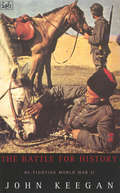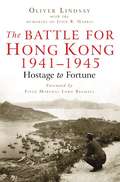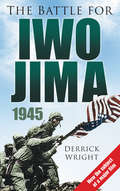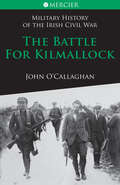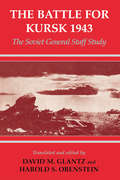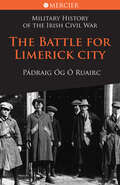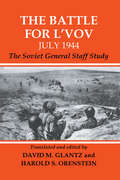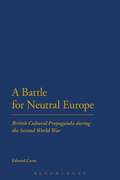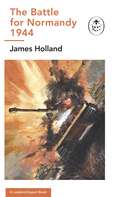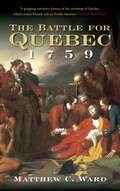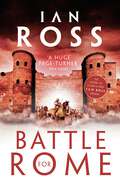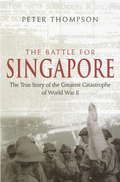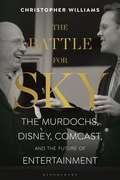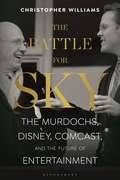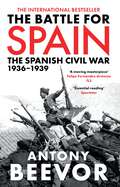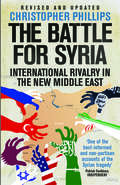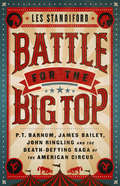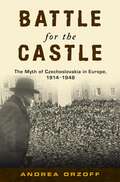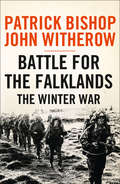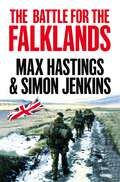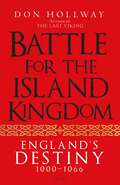- Table View
- List View
The Battle For History: Refighting World War Two (The\barbara Frum Lecture Ser.)
by John KeeganAlthough 50 years have passed since the end of World War II, there has as yet been no definitive history of that conflict. Existing histories have raised as many questions as they answer: Did Roosevelt have foreknowledge of the attack on Pearl Harbour? Could the Allies have invaded France before 1944? Might bombing the Auschwitz railway have impeded the course of the Holocaust? John Keegan here assesses the literature that has emerged from World War II - and the controversies it has generated - in a book that combines stunning erudition with crisp prose and highly personal discernment.
The Battle For Hong Kong 1941-1945: Hostage to Fortune
by Oliver LindsayA study of the Far Eastern War that provides an enquiry into the debacle which led to over 12,000 British, Canadian, Indian and Chinese defenders surrendering Hong Kong on Christmas Day 1941. This account of the campaign provides a read for those interested in the Second World War or the history of the Far East.
The Battle for Iwo Jima 1945
by Derrick WrightIwo Jima was the United States Marine Corps' toughest ever battle and a turning point in the Pacific War. In February 1945, three Marine Divisions stormed the island's shores in what was supposed to be a ten-day battle, but they had reckoned without General Tadamichi Kuribayashi, the enemy commander.
The Battle for Kilmallock: Military History Of The Irish Civil War (Mercier's History of the Irish Civil War #3)
by John O'Callaghan* Part of popular series of titles on the Military History of the Irish Civil War * The only in-depth study of this battle * Publicity campaigns planned with the Irish Sword, History Ireland, Newstalk's Talking History and more
The Battle for Kursk, 1943: The Soviet General Staff Study (Soviet (Russian) Study of War)
by DAVID M. GLANTZ; HAROLD S. ORENSTEINThis volume offers detailed information about the Red Army's preparation for and conduct of the Battle of Kursk, the nature of the war on the German Eastern Front, and on the range of horrors that have characterized warfare in the 20th century.
The Battle for Kursk, 1943: The Soviet General Staff Study (Soviet (Russian) Study of War)
by David M. Glantz Harold S. OrensteinThis volume offers detailed information about the Red Army's preparation for and conduct of the Battle of Kursk, the nature of the war on the German Eastern Front, and on the range of horrors that have characterized warfare in the 20th century.
The Battle for Limerick City: Military History Of The Irish Civil War (Mercier's History of the Irish Civil War #2)
by Pádraig Óg Ó RuaircThe first of a six book series on titles on the Military History Of The Irish Civil War, this is an in-depth study of the battle for Limerick city. The story concentrates on the vicious battle that took place between Republican and Provisional Government forces for the control of Limerick City. Occurring in the early days of the Civil War, hostilities arrived in Limerick with a whimper rather than a bang. Outnumbered and out-gunned, the Pro-Treaty Commander of the city, Michael Brennan, negotiated a truce with the Anti-Treaty Chief of Staff, Liam Lynch. But the benefit of this lull in fighting accrued almost entirely to the Pro-Treaty side, gaining them time for reinforcements and weaponry to arrive. When it did, the city became a battleground of extreme viciousness. Several buildings were shelled by 18-pounder guns at point-blank range. The fighting around the Strand barracks was particularly heavy. Padraig Ó Ruairc offers a fresh perspective on the struggle that reduced the viability of the Republican's hoped-for Munster Republic and set the stage for the battle of Kilmallock which checked the pro-treaty rout that the initial stages of the Civil War had been.
The Battle for L'vov July 1944: The Soviet General Staff Study (Soviet (Russian) Study of War #No. 13)
by David M. Glantz Harold S. OrensteinThe Red Army's summer offensive of 1944 against Hitler's Wehrmacht was unprecedented in terms of its scale, scope, and strategic intent and impact. This study details how the Red Army accomplished this feat in the words of those individuals who planned and orchestrated the offensive.
The Battle for L'vov July 1944: The Soviet General Staff Study (Soviet (Russian) Study of War)
by David Glantz Harold S. OrensteinThe Red Army's summer offensive of 1944 against Hitler's Wehrmacht was unprecedented in terms of its scale, scope, and strategic intent and impact. This study details how the Red Army accomplished this feat in the words of those individuals who planned and orchestrated the offensive.
A Battle for Neutral Europe: British Cultural Propaganda during the Second World War
by Edward CorseA Battle for Neutral Europe describes and analyses the forgotten story of the British government's cultural propaganda organization, the British Council, in its campaign to win the hearts and minds of people in neutral Europe during the Second World War. The book draws on a range of previously unused material from archives from across Europe and private memoirs to provide a unique insight into the work of the leading British artists, scientists, musicians and other cultural figures who travelled to Spain, Portugal, Sweden and Turkey at great personal risk to promote British life and thought in a time of war. Edward Corse shows how the British Council played a subtle but crucial role in Britain's war effort and draws together the lessons of the British Council experience to produce a new model of cultural propaganda.
A Battle for Neutral Europe: British Cultural Propaganda during the Second World War
by Edward CorseA Battle for Neutral Europe describes and analyses the forgotten story of the British government's cultural propaganda organization, the British Council, in its campaign to win the hearts and minds of people in neutral Europe during the Second World War. The book draws on a range of previously unused material from archives from across Europe and private memoirs to provide a unique insight into the work of the leading British artists, scientists, musicians and other cultural figures who travelled to Spain, Portugal, Sweden and Turkey at great personal risk to promote British life and thought in a time of war. Edward Corse shows how the British Council played a subtle but crucial role in Britain's war effort and draws together the lessons of the British Council experience to produce a new model of cultural propaganda.
The Battle for Normandy, 1944: (WW2 #9) (The Ladybird Expert Series #15)
by James HollandBOOK 9 OF THE LADYBIRD EXPERT HISTORY OF THE SECOND WORLD WAR, FROM AWARD-WINNING HISTORIAN JAMES HOLLANDFeaturing stunning illustrations from Keith Burns, bringing the story to life in vivid detailWhy did the Allies attack on D-Day?How did the Allies pick Normandy as a target?What was Operation Overload, the second front against the Nazis?JUNE 6 1944D-Day was a deciding conflict in World War II. But the invasion was not a straightforward attack.From feeding Nazi spies false information on the attack, to developing new technology like the Mulberry harbours, D-Day changed the course of the War for good.THE LARGEST SEABORNE INVASION IN HISTORYWritten by historian, author and broadcaster James Holland, The Battle for Normandy is an essential introduction to the naval invasion that began the liberation of Western Europe from the Nazis.__________Discover the full Ladybird Expert WW2 series:BlitzkriegThe Battle of BritainBattle of the AtlanticThe Desert WarThe Eastern FrontThe Pacific WarThe Bomber WarThe War in ItalyThe Battle for NormandyThe War in BurmaVictory in EuropeVictory Against Japan
The Battle for Quebec 1759
by Matthew C WardA concise and readable history of the British war against the French for control of Canada
Battle for Rome (Twilight of Empire #3)
by Ian RossThe Roman Empire is on the brink of civil war... Only Maxentius, tyrant of Rome, stands between the emperor Constantine and supreme power in the west. Aurelius Castus is now a tribune in Constantine's army. But great honour brings new challenges: Castus is tormented by suspicions that his young wife has been unfaithful. And as Constantine becomes increasingly devoted to Christianity, he is forced to ask himself whether he is backing the wrong man. The coming war will decide the fate of empire. But Castus's own battle will carry him much further...
The Battle For Singapore: The true story of the greatest catastrophe of World War II
by Peter ThompsonThe Fall of Singapore on 15 February 1942 is a military disaster of enduring fascination. For the 60th anniversary of the liberation of the island, Peter Thompson tells the explosive story of the Malayan campaign, the siege of Singapore, the ignominious surrender to a much smaller Japanese force, and the Japanese occupation through the eyes of those who were there - the soldiers of all nationalities and members of Singapore's beleaguered population. An enthralling and perceptive account, which never loses sight of the human cost of the tragedy - Yorkshire Evening Post. An insightful and dramatic analysis - The Good Book Guide
The Battle for Sky: The Murdochs, Disney, Comcast and the Future of Entertainment
by Christopher WilliamsFrom perilous early years through clashes with the BBC and BT, not to mention the News Corporation bid for full control that failed in the wake of 2010's phone hacking scandal, there has been no shortage of drama in Sky's history – nor in its likely future. In 2018, the organization was the target of bids from two true titans of the global media industry – Disney and Comcast – with a dramatic bidding war waged for ultimate ownership. Throw in an industry already shaken by the arrival of newer media players such as Netflix, the declining circulation of Murdoch newspapers such as The Sun and The Times, as well as the UK government's scrutiny of the Murdoch family's influence on UK media, and the scene was set for a major corporate battle of a size rarely seen on the global business stage.But how exactly did Comcast win in the battle for shareholder votes? How will the Murdoch empire fare when the dust finally settles? And what does it mean now for the future of entertainment in a streaming, downloadable and digital world?Featuring interviews with key individuals and stakeholders from around the world, The Battle for Sky offers a timely and intriguing glimpse into the workings of media empires, and a gripping account of one of the largest corporate battles in recent years.
The Battle for Sky: The Murdochs, Disney, Comcast and the Future of Entertainment
by Christopher WilliamsFrom perilous early years through clashes with the BBC and BT, not to mention the News Corporation bid for full control that failed in the wake of 2010's phone hacking scandal, there has been no shortage of drama in Sky's history – nor in its likely future. In 2018, the organization was the target of bids from two true titans of the global media industry – Disney and Comcast – with a dramatic bidding war waged for ultimate ownership. Throw in an industry already shaken by the arrival of newer media players such as Netflix, the declining circulation of Murdoch newspapers such as The Sun and The Times, as well as the UK government's scrutiny of the Murdoch family's influence on UK media, and the scene was set for a major corporate battle of a size rarely seen on the global business stage.But how exactly did Comcast win in the battle for shareholder votes? How will the Murdoch empire fare when the dust finally settles? And what does it mean now for the future of entertainment in a streaming, downloadable and digital world?Featuring interviews with key individuals and stakeholders from around the world, The Battle for Sky offers a timely and intriguing glimpse into the workings of media empires, and a gripping account of one of the largest corporate battles in recent years.
The Battle for Spain: The Spanish Civil War 1936-1939
by Antony Beevor'Fascination lies in the human drama, superbly captured by Beevor ... A vivid chronicle of a dreadful time and place' Max Hastings, Sunday Times'A moving masterpiece' TLSThe civil war that tore Spain apart between 1936 and 1939 and attracted liberals and socialists from across the world to support the cause against Franco was one of the most hard-fought and bitterest conflicts of the 20th century: a war of atrocities and political genocide and a military testing ground before WWII for the Russians, Italians and Germans, whose Condor Legion so notoriously destroyed Guernica.Antony Beevor's account narrates the origins of the Civil War and its violent and dramatic course from the coup d'etat in July 1936 through the savage fighting of the next three years which ended in catastrophic defeat for the Republicans in 1939. And he succeeds especially well in unravelling the complex political and regional forces that played such an important part in the origins and history of the war.
The Battle for Syria: International Rivalry in the New Middle East
by Christopher PhillipsAn unprecedented analysis of the crucial but underexplored roles the United States and other nations have played in shaping Syria’s ongoing civil war“One of the best informed and non-partisan accounts of the Syrian tragedy yet published.”—Patrick Cockburn, Independent Syria’s brutal, long-lasting civil war is widely viewed as a domestic contest that began in 2011 and only later drew foreign nations into the fray. But in this book Christopher Phillips shows the crucial roles that were played by the United States, Russia, Iran, Saudi Arabia, Turkey, and Qatar in Syria’s war right from the start. Phillips untangles the international influences on the tragic conflict and illuminates the West’s strategy against ISIS, the decline of U.S. power in the region, and much more. Originally published in 2016, the book has been updated with two new chapters.  
Battle for the Big Top: P.T. Barnum, James Bailey, John Ringling, and the Death-Defying Saga of the American Circus
by Les StandifordA New York Times bestselling author writes the untold story of three Golden Age titans and the confrontations, cutthroat business strategies, and eccentric personalities that built the Ringling Bros., Barnum & Bailey Circus. Millions have sat under the &“big top,&” watching as trapeze artists glide and clowns entertain, but few know the captivating stories behind the men whose creativity, ingenuity, and determination created one of our country&’s most beloved pastimes.In Battle for the Big Top, New York Times–bestselling author Les Standiford brings to life a remarkable era when three circus kings—James Bailey, P.T. Barnum, and John Ringling—all vied for control of the vastly profitable and influential American Circus. Ultimately, the rivalry of these three men resulted in the creation of an institution that would surpass all intentions and, for 147 years, hold a nation spellbound. Filled with details of their ever-evolving showmanship, business acumen, and personal magnetism, this Ragtime-like narrative will delight and enchant circus-lovers and anyone fascinated by the American experience.
Battle for the Castle: The Myth of Czechoslovakia in Europe, 1914-1948
by Andrea OrzoffAfter World War I, diplomats and leaders at the Paris Peace Talks redrew the map of Europe, carving up ancient empires and transforming Europe's eastern half into new nation-states. Drawing heavily on the past, the leaders of these young countries crafted national mythologies and deployed them at home and abroad. Domestically, myths were a tool for legitimating the new state with fractious electorates. In Great Power capitals, they were used to curry favor and to compete with the mythologies and propaganda of other insecure postwar states. The new postwar state of Czechoslovakia forged a reputation as Europe's democratic outpost in the East, an island of enlightened tolerance amid an increasingly fascist Central and Eastern Europe. In Battle for the Castle, Andrea Orzoff traces the myth of Czechoslovakia as an ideal democracy. The architects of the myth were two academics who had fled Austria-Hungary in the Great War's early years. Tomáas Garrigue Masaryk, who became Czechoslovakia's first president, and Edvard Benes, its longtime foreign minister and later president, propagated the idea of the Czechs as a tolerant, prosperous, and cosmopolitan people, devoted to European ideals, and Czechoslovakia as a Western ally capable of containing both German aggression and Bolshevik radicalism. Deeply distrustful of Czech political parties and Parliamentary leaders, Benes and Masaryk created an informal political organization known as the Hrad or "Castle." This powerful coalition of intellectuals, journalists, businessmen, religious leaders, and Great War veterans struggled with Parliamentary leaders to set the country's political agenda and advance the myth. Abroad, the Castle wielded the national myth to claim the attention and defense of the West against its increasingly hungry neighbors. When Hitler occupied the country, the mythic Czechoslovakia gained power as its leaders went into wartime exile. Once Czechoslovakia regained its independence after 1945, the Castle myth reappeared. After the Communist coup of 1948, many Castle politicians went into exile in America, where they wrote the Castle myth of an idealized Czechoslovakia into academic and political discourse. Battle for the Castle demonstrates how this founding myth became enshrined in Czechoslovak and European history. It powerfully articulates the centrality of propaganda and the mass media to interwar European cultural diplomacy and politics, and the tense, combative atmosphere of European international relations from the beginning of the First World War well past the end of the Second.
Battle for the Castle: The Myth of Czechoslovakia in Europe, 1914-1948
by Andrea OrzoffAfter World War I, diplomats and leaders at the Paris Peace Talks redrew the map of Europe, carving up ancient empires and transforming Europe's eastern half into new nation-states. Drawing heavily on the past, the leaders of these young countries crafted national mythologies and deployed them at home and abroad. Domestically, myths were a tool for legitimating the new state with fractious electorates. In Great Power capitals, they were used to curry favor and to compete with the mythologies and propaganda of other insecure postwar states. The new postwar state of Czechoslovakia forged a reputation as Europe's democratic outpost in the East, an island of enlightened tolerance amid an increasingly fascist Central and Eastern Europe. In Battle for the Castle, Andrea Orzoff traces the myth of Czechoslovakia as an ideal democracy. The architects of the myth were two academics who had fled Austria-Hungary in the Great War's early years. Tomáas Garrigue Masaryk, who became Czechoslovakia's first president, and Edvard Benes, its longtime foreign minister and later president, propagated the idea of the Czechs as a tolerant, prosperous, and cosmopolitan people, devoted to European ideals, and Czechoslovakia as a Western ally capable of containing both German aggression and Bolshevik radicalism. Deeply distrustful of Czech political parties and Parliamentary leaders, Benes and Masaryk created an informal political organization known as the Hrad or "Castle." This powerful coalition of intellectuals, journalists, businessmen, religious leaders, and Great War veterans struggled with Parliamentary leaders to set the country's political agenda and advance the myth. Abroad, the Castle wielded the national myth to claim the attention and defense of the West against its increasingly hungry neighbors. When Hitler occupied the country, the mythic Czechoslovakia gained power as its leaders went into wartime exile. Once Czechoslovakia regained its independence after 1945, the Castle myth reappeared. After the Communist coup of 1948, many Castle politicians went into exile in America, where they wrote the Castle myth of an idealized Czechoslovakia into academic and political discourse. Battle for the Castle demonstrates how this founding myth became enshrined in Czechoslovak and European history. It powerfully articulates the centrality of propaganda and the mass media to interwar European cultural diplomacy and politics, and the tense, combative atmosphere of European international relations from the beginning of the First World War well past the end of the Second.
Battle for the Falklands: The Winter War
by Patrick Bishop John Witherow‘Boldly planned, bravely executed and brilliantly accomplished’ was Margaret Thatcher’s assessment of the Falklands campaign. But what did the war mean to the men in the trenches and below decks?
The Battle for the Falklands
by Max Hastings Simon JenkinsThe Falklands War was one of the strangest in British history – 28,000 men sent to fight for a tiny relic of empire 8,000 miles from home. At the time, many Britons saw it as a tragic absurdity, but the British victory confirmed the quality of British arms and boosted the political fortunes of the Conservative government. But it left a chequered aftermath; it was of no wider significance for British interests and taught no lessons. It has since been overshadowed by the two Gulf Wars, however, its political ramifications cannot be overestimated. Max Hastings’ and Simon Jenkins’ account of the conflict is a modern classic of war reportage and the definitive book on the war. Republished as part of the Pan Military Classics series, The Battle for the Falklands is a vivid chronicle of a call to arms and a thoughtful and informed analysis of an astonishing chapter in the history of our times.
Battle for the Island Kingdom: England's Destiny 1000–1066
by Don HollwayA rich history of the years leading up to 1066 when Vikings, Anglo-Saxons and Normans vied for the English crown. A tale of loyalty, treason and military might. In a saga reminiscent of Game of Thrones and The Last Kingdom, Battle for the Island Kingdom reveals the life-and-death struggle for power which changed the course of history. The six decades leading up to 1066 were defined by bloody wars and intrigues, in which three peoples vied for supremacy over the island kingdom. In this epic retelling, Don Hollway (The Last Viking) recounts the clashes of Vikings, Anglo-Saxons and Normans, their warlords and their conniving queens. It begins with the Viking Cnut the Great, forging three nations into his North Sea Empire while his Saxon wife Aelfgifu rules in his stead and schemes for England's throne. Her archenemy is Emma of Normandy, widow of Saxon king Aethelred, claiming Cnut's realm in exchange for her hand in marriage. Their sons become rivals, pawns in their mothers' wars until they can secure their own destinies. And always in the shadows is Godwin of Wessex, playing all sides to become the power behind the throne until his son Harold emerges as king of all of England. But Harold's brother Tostig turns traitor, abandons the Anglo-Saxons and joins the army of the last great Viking, Harald Hardrada, where together they meet their fate at the battle of Stamford Bridge. And all this time watching from across the water is William, the Bastard, fighting to secure his own Norman dukedom, but with an eye on the English crown.
